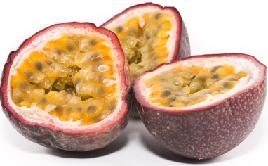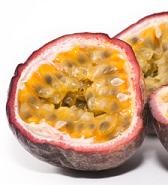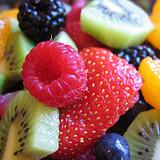Passion Fruit Nutrition Facts,
Health Benefits of Passion Fruit
All about passion fruit nutrition information, nutritional benefits of passion fruit, calories in a passion fruit
There are many varieties of passion fruit but it’s simplest to think of them as either a purple or yellow variety. The purple fruit is what we normally purchase, about the size of a golf ball, it’s deliciously sweet. The yellow variety grows a lot bigger, similar to a mango. We often don’t see the passion fruit in this color as it’s used to make passion fruit juice. In juice form it’s often sold mixed with other fruits to give it a sweeter taste.
When eating a purple passion fruit, simply cut in half, scoop out the contents and eat everything, it’s delicious. The yellow variety contains more water and it's therefore lower in both calories and fat. Neither contains any cholesterol. In the table below we’ve compared the nutritional difference between each fruit. The purple fruit is very high in carbohydrates with a 100g single serving containing 23 grams. It’s also very high in fiber. In fact the purple variety has a higher concentration of vitamins and minerals with the exception of vitamin A and B3 (niacin).
The purple fruit is full of vitamin C, and in addition provides a good source of vitamins A, B2 (riboflavin), B3 (niacin), and iron, whilst the yellow variety has nearly double the amount of vitamin A and provides a good source of vitamins B3 (niacin) and C.
Given its high carbohydrate content, this fruit should give you lots of energy. It’s also believed to help fight cholesterol and is beneficial in protecting you from heart disease.
When purchasing, the fruits that are slightly wrinkly are a good sign they are ripe and juicy.
Compare passion fruit nutrition facts to the other fruits.

Nutritional Value of Passion Fruit
| Passion fruit nutritional value per 100 g (3.5 oz) | ||
|---|---|---|
| Proximates: | ||
| Nutrient | Passion-fruit, (granadilla), purple, raw. Refuse: 48% (Shell). Scientific Name: Passiflora edulis | Passion-fruit juice, yellow, raw. Scientific Name: Passiflora laurifolia |
| Water | 72.93 g | 84.21 g |
| Energy | 406 kJ (97 kcal) | 251 kJ (60 kcal) |
| Protein | 2.20 g | 0.67 g |
| Carbohydrates | 23.38 g | 14.45 g |
| Total Fat: | 0.70 g | 0.18 g |
| Fiber | 10.4 g | 0.2 g |
| Cholesterol | 0 mg | 0 g |
| Minerals: | ||
| Calcium, Ca | 12 mg (1%) | 4 mg (0.4%) |
| Iron, Fe | 1.60 mg (9%) | 0.36 mg (2%) |
| Magnesium, Mg | 29 mg (7%) | 17 mg (4%) |
| Phosphorus, P | 68 mg (7%) | 25 mg (2.5%) |
| Potassium, K | 348 mg (7%) | 278 mg (6%) |
| Sodium, Na | 28 mg (1%) | 6 mg (0.3%) |
| Zinc, Zn | 0.10 mg (0.7%) | 0.06 mg (0.4%) |
| Copper, Cu | 0.086 mg (4%) | 0.050 mg (3%) |
| Selenium, Se | 0.6 mcg (1%) | 0.1 mcg (0.1%) |
| Vitamins: | ||
| Vitamin C | 30.0 mg (50%) | 18.2 mg (30%) |
| Thiamine (Vit. B1) | 0 mg | 0 mg |
| Riboflavin (Vit. B2) | 0.130 mg (8%) | 0.101 mg (6%) |
| Niacin (Vit. B3) | 1.500 mg (8%) | 2.240 mg (11%) |
| Vitamin B6 | 0.100 mg (5%) | 0.060 mg (3%) |
| Folate (Vit. B9) | 14 mcg (4%) | 8 mcg (2%) |
| Vitamin A | 1272 IU (25%) | 2410 IU (48%) |
| Vitamin E | 0.02 mg (0.1%) | - |
| Vitamin K | 0.7 mcg (1%) | - |
| Percentages are relative to US Recommended Daily Intake (RDI) for adults. | ||
Author: Lana Soko
You Might Also Like:
 Passion Fruit Calories Passion Fruit Calories |
 Calories in Fruit Calories in Fruit |
 Low Calorie Diet Plans Low Calorie Diet Plans |
 How to Count Calories How to Count Calories |
Like This Page?
|
Share This Page:
|
Search Our Site:

Free E-Book:
We Recommend:
Looking to get your body into great shape? Get the very best results for your efforts and money! Save your valuable time from surfing the internet. These are theBestselling Weight Loss Programs

Programs that work and have thousands of satisfied customers worldwide!

 |
